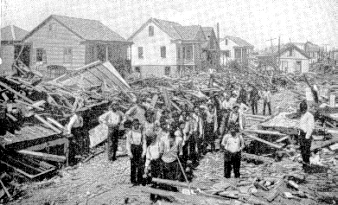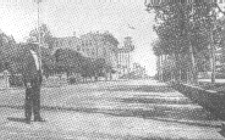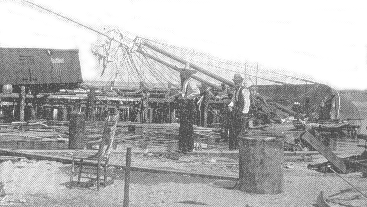
On September 7th, there was official warning of the approach of a severe storm, but no one expected such a tempest as was destined to devastate the city. Such warning as was given was rather addressed to mariners about to go to sea, rather than those living on shore.
Simultaneously with the approach of the hurricane was a great wind from the north, known locally as a "Norther." This developed at Galveston about 2 AM, on September 8th. The approaching hurricane from the east and southeast had been driving a great wall of water toward the shore at Galveston. The tremendous wind storm from the north acted as a counter force or check to the hurricane element.
The north wind blew the water from Galveston Bay, on the one side of the city, and the storm in the Gulf hurled its battalions of waves upon the beach side of the city.
Early in the day, the battle between these two contending forces offered a magnificent spectacle. As long gas the north wind held strong the city was safe. While the winds dashed great volumes of water over the wharves and flooded some streets in the business portion of the city and the waters of the Gulf on the other side of the city encroached upon the streets near the beach, there was no particular fear of serious consequences, but about noon the barometer, which had been very low, suddenly began to drop at a rate that presaged a storm of tremendous violence.
Following this came the warning that the wind would, before many
house, change from the north to the southeast and the fury of the wall
of water being driven upon Galveston by the approaching hurricane would
be added all the tremendous force of the wind that had previously acted
as a partial check to the storm.
.
Return to Menu / Next
With the first shifting of the wind, the waters of the Gulf swept
over the city. Houses near the beach began to crumble and collapse,
their timbers being picked up by the wind and waves and thrown in a long
line of battering rams against the structures. Men, women, and children
fled from their homes and sought safety in higher portions of the city,
or in buildings more strongly built. Some were taken out in boats,
some in wagons, some waded through the waters, but the flood rose so rapidly
that the approach of night found many hundreds battling in the waters,
unable to reach places of safety. The air was full of missiles.
.

The wind tore slats from roofs and carried them along like wafers. A person struck by on of these was certain to be maimed, if not killed outright. The waves, with each succeeding sweep of the in-rushing tide, brought a greater volume of wreckage, as house after house toppled and fell into the waters. So tremendous was the roar of the storm that all other sounds were dwarfed and drowned. Massive buildings were crushed like egg shells, great timbers were carried through the air though they were of no weight, and the winds and the waves swept everything before them.
Hundreds took refuge in the Tremont Hotel. Men, women and children
grouped about the stairways and in the galleries and rooms, bemoaning their
losses of kindred and fortune.
.

Monster ocean steamers weighing thousands of tons had been picked
up like toys, driven across the lowlands, and thrown farm from their moorings.
One big steamship was hurled through three bridges. Another, weighing
4,000 tons, was carried twenty-two miles from deep water, and dashed against
a bayou bluff in another county.
.

A remarkable feature about the storm is the disparity in the depth of water in different portions of the city, and the undoubted fact that the waters subside on the north side of the city hours before they did on the south side.
Without apparent reason the waters suddenly began to subside at 1:45 AM. Within 20 minutes they had gone down two feet, and before daylight the streets were practically freed of the flood waters. In the meantime, the wind veered to the southeast.
These peculiarities are explained by the topography of the island. Broadway, which marks the center, or middle of the city proper, in on the ridge, from which the land slopes on one side toward the by, and on the other, toward the Gulf. The waters from the Gulf passed over this ridge and swept on toward the bay during the most furious stages of the storm, but the full energies of wind and water were directed upon that portion of the city between the Gulf and the Broadway Ridge. Of the lives lost in the city, 90% were between the Gulf and Broadway.